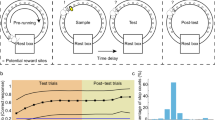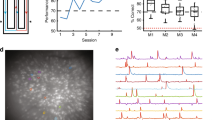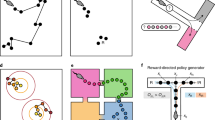Abstract
Hippocampal information processing is discretized by oscillations, and the ensemble activity of place cells is organized into temporal sequences bounded by theta cycles. Theta sequences represent time-compressed trajectories through space. Their forward-directed nature makes them an intuitive candidate mechanism for planning future trajectories, but their connection to goal-directed behavior remains unclear. As rats performed a value-guided decision-making task, the extent to which theta sequences projected ahead of the animal's current location varied on a moment-by-moment basis depending on the rat's goals. Look-ahead extended farther on journeys to distant goals than on journeys to more proximal goals and was predictive of the animal's destination. On arrival at goals, however, look-ahead was similar regardless of where the animal began its journey from. Together, these results provide evidence that hippocampal theta sequences contain information related to goals or intentions, pointing toward a potential spatial basis for planning.
This is a preview of subscription content, access via your institution
Access options
Subscribe to this journal
Receive 12 print issues and online access
$209.00 per year
only $17.42 per issue
Buy this article
- Purchase on Springer Link
- Instant access to full article PDF
Prices may be subject to local taxes which are calculated during checkout







Similar content being viewed by others
References
Cohen, N.J. & Eichenbaum, H. Memory, Amnesia and the Hippocampal System (MIT Press, 1993).
Lisman, J. & Redish, A.D. Prediction, sequences and the hippocampus. Phil. Trans. R. Soc. Lond. B 364, 1193–1201 (2009).
Schacter, D.L. & Addis, D. On the nature of medial temporal lobe contributions to the constructive simulation of future events. Phil. Trans. R. Soc. Lond. B 364, 1245 (2009).
Barron, H.C., Dolan, R. & Behrens, T. Online evaluation of novel choices by simultaneous representation of multiple memories. Nat. Neurosci. 16, 1492–1498 (2013).
Wikenheiser, A. & Redish, A. Decoding the cognitive map: ensemble hippocampal sequences and decision making. Curr. Opin. Neurobiol. published online, doi:10.1016/j.conb.2014.10.002 (17 October 2014).
Peters, J. & Büchel, C. Episodic future thinking reduces reward delay discounting through an enhancement of prefrontal-mediotemporal interactions. Neuron 66, 138–148 (2010).
Viard, A., Doeller, C.F., Hartley, T., Bird, C.M. & Burgess, N. Anterior hippocampus and goal-directed spatial decision making. J. Neurosci. 31, 4613–4621 (2011).
Bornstein, A.M. & Daw, N.D. Cortical and hippocampal correlates of deliberation during model-based decisions for rewards in humans. PLoS Comput. Biol. 9, e1003387 (2013).
Spiers, H.J. & Barry, C. Neural systems supporting navigation. Curr. Opin. Behav. Sci. 1, 47–55 (2015).
O'Keefe, J. & Nadel, L. The Hippocampus as a Cognitive Map (Clarendon Press, Oxford, 1978).
Redish, A.D. Beyond the Cognitive Map: From Place Cells to Episodic Memory (MIT Press, 1999).
Skaggs, W.E., McNaughton, B.L., Wilson, M.A. & Barnes, C.A. Theta phase precession in hippocampal neuronal populations and the compression of temporal sequences. Hippocampus 6, 149–172 (1996).
Tsodyks, M.V., Skaggs, W.E., Sejnowski, T.J. & McNaughton, B.L. Population dynamics and theta rhythm phase precession of hippocampal place cell firing: A spiking neuron model. Hippocampus 6, 271–280 (1996).
Dragoi, G. & Buzsaki, G. Temporal encoding of place sequences by hippocampal cell assemblies. Neuron 50, 145–157 (2006).
Foster, D.J. & Wilson, M.A. Hippocampal theta sequences. Hippocampus 17, 1093–1099 (2007).
Maurer, A.P., Burke, S.N., Lipa, P., Skaggs, W.E. & Barnes, C.A. Greater running speeds result in altered hippocampal phase sequence dynamics. Hippocampus 22, 737–747 (2012).
O'Keefe, J. & Recce, M. Phase relationship between hippocampal place units and the EEG theta rhythm. Hippocampus 3, 317–330 (1993).
Maurer, A.P. & McNaughton, B.L. Network and intrinsic cellular mechanisms underlying theta phase precession of hippocampal neurons. Trends Neurosci. 30, 325–333 (2007).
Gupta, A.S., van der Meer, M., Touretzky, D. & Redish, A. Segmentation of spatial experience by hippocampal θ sequences. Nat. Neurosci. 15, 1032–1039 (2012).
Johnson, A. & Redish, A.D. Neural ensembles in CA3 transiently encode paths forward of the animal at a decision point. J. Neurosci. 27, 12176–12189 (2007).
Wikenheiser, A.M., Stephens, D. & Redish, A. Subjective costs drive overly patient foraging strategies in rats on an intertemporal foraging task. Proc. Natl. Acad. Sci. USA 110, 8308–8313 (2013).
Belluscio, M.A., Mizuseki, K., Schmidt, R., Kempter, R. & Buzsáki, G. Cross-frequency phase-phase coupling between theta and gamma oscillations in the hippocampus. J. Neurosci. 32, 423–435 (2012).
Jensen, O. & Lisman, J.E. Hippocampal CA3 region predicts memory sequences: accounting for the phase precession of place cells. Learn. Mem. 3, 279–287 (1996).
Lisman, J.E. & Jensen, O. The theta-gamma neural code. Neuron 77, 1002–1016 (2013).
Mehta, M.R. & McNaughton, B.L. Rapid changes in hippocampal population code during behavior: A case for Hebbian learning in vivo. Soc. Neurosci. Abstr. 758.3 (1996).
Mehta, M.R., Barnes, C.A. & McNaughton, B.L. Experience-dependent, asymmetric expansion of hippocampal place fields. Proc. Natl. Acad. Sci. USA 94, 8918–8921 (1997).
Mehta, M.R., Quirk, M.C. & Wilson, M.A. Experience-dependent asymmetric shape of hippocampal receptive fields. Neuron 25, 707–715 (2000).
Pfeiffer, B.E. & Foster, D. Hippocampal place-cell sequences depict future paths to remembered goals. Nature 497, 74–79 (2013).
Singer, A.C., Carr, M., Karlsson, M. & Frank, L. Hippocampal swr activity predicts correct decisions during the initial learning of an alternation task. Neuron 77, 1163–1173 (2013).
Jadhav, S.P., Kemere, C., German, P. & Frank, L. Awake hippocampal sharp-wave ripples support spatial memory. Science 336, 1454–1458 (2012).
Pastalkova, E., Itskov, V., Amarasingham, A. & Buzsaki, G. Internally generated cell assembly sequences in the rat hippocampus. Science 321, 1322–1327 (2008).
Takahashi, M., Lauwereyns, J., Sakurai, Y. & Tsukada, M. A code for spatial alternation during fixation in rat hippocampal CA1 neurons. J. Neurophysiol. 102, 556–567 (2009).
Takahashi, M., Nishida, H., Redish, A.D. & Lauwereyns, J. Theta phase shift in spike timing and modulation of gamma oscillation: a dynamic code for spatial alternation during fixation in rat hippocampal area ca1. J. Neurophysiol. 111, 1601–1614 (2014).
Schmidt, B. & Redish, A.D. Neuroscience: navigation with a cognitive map. Nature 497, 42–43 (2013).
Howard, L.R. et al. The hippocampus and entorhinal cortex encode the path and euclidean distances to goals during navigation. Curr. Biol. 24, 1331–1340 (2014).
Robbe, D. et al. Cannabinoids reveal importance of spike timing coordination in hippocampal function. Nat. Neurosci. 9, 1526–1533 (2006).
Robbe, D. & Buzsaki, G. Alteration of theta timescale dynamics of hippocampal place cells by a cannabinoid is associated with memory impairment. J. Neurosci. 29, 12597–12605 (2009).
Colgin, L.L. et al. Frequency of gamma oscillations routes flow of information in the hippocampus. Nature 462, 353–357 (2009).
Bieri, K.W., Bobbitt, K.N. & Colgin, L.L. Slow and fast gamma rhythms coordinate different spatial coding modes in hippocampal place cells. Neuron 82, 670–681 (2014).
Cabral, H.O. et al. Oscillatory dynamics and place field maps reflect hippocampal ensemble processing of sequence and place memory under NMDA receptor control. Neuron 81, 402–415 (2014).
van der Meer, M.A.A. & Redish, A.D. Theta phase precession in rat ventral striatum links place and reward information. J. Neurosci. 31, 2843–2854 (2011).
Malhotra, S., Cross, R.W. & van der Meer, M.A. Theta phase precession beyond the hippocampus. Rev. Neurosci. 23, 39–65 (2012).
Siapas, A.G., Lubenov, E.V. & Wilson, M.A. Prefrontal phase locking to hippocampal theta oscillations. Neuron 46, 141–151 (2005).
Jones, M.W. & Wilson, M.A. Phase precession of medial prefrontal cortical activity relative to the hippocampal theta rhythm. Hippocampus 15, 867–873 (2005).
Benchenane, K. et al. Coherent theta oscillations and reorganization of spike timing in the hippocampal- prefrontal network upon learning. Neuron 66, 921–936 (2010).
Hyman, J.M., Zilli, E.A., Paley, A.M. & Hasselmo, M.E. Working memory performance correlates with prefrontal-hippocampal theta interactions but not with prefrontal neuron firing rates. Front. Integr. Neurosci. published online, doi:10.3389/neuro.07.002.2010 (10 March 2010).
Gupta, K., Erdem, U. & Hasselmo, M. Modeling of grid cell activity demonstrates in vivo entorhinal look-ahead properties. Neuroscience 247, 395–411 (2013).
Erdem, U.M. & Hasselmo, M.E. A biologically inspired hierarchical goal directed navigation model. J. Physiol. Paris 108, 28–37 (2014).
Mel, B.W. NMDA-based pattern discrimination in a modeled cortical neuron. Neural Comput. 4, 502–517 (1992).
Branco, T., Clark, B.A. & Häusser, M. Dendritic discrimination of temporal input sequences in cortical neurons. Science 329, 1671–1675 (2010).
Jackson, J.C., Johnson, A. & Redish, A.D. Hippocampal sharp waves and reactivation during awake states depend on repeated sequential experience. J. Neurosci. 26, 12415–12426 (2006).
Wikenheiser, A.M. & Redish, A.D. Changes in reward contingency modulate the trial to trial variability of hippocampal place cells. J. Neurophysiol. 106, 589–598 (2011).
Redish, A.D. & Schmitzer-Torbert, N.C. MCLUST spike sorting toolbox, version 3.0. <http://redishlab.neuroscience.umn.edu/> (2008).
Schmitzer-Torbert, N., Jackson, J., Henze, D., Harris, K. & Redish, A. Quantitative measures of cluster quality for use in extracellular recordings. Neuroscience 131, 1–11 (2005).
Carr, M.F., Jadhav, S.P. & Frank, L.M. Hippocampal replay in the awake state: a potential substrate for memory consolidation and retrieval. Nat. Neurosci. 14, 147–153 (2011).
Csicsvari, J., Hirase, H., Czurkó, A. & Buzsáki, G. Oscillatory coupling of hippocampal pyramidal cells and interneurons in the behaving rat. J. Neurosci. 19, 274–287 (1999).
Gupta, A.S., van der Meer, M.A.A., Touretzky, D.S. & Redish, A.D. Hippocampal replay is not a simple function of experience. Neuron 65, 695–705 (2010).
Hosmer, D.W. Jr., Lemeshow, S. & Sturdivant, R.X. Applied Logistic Regression (John Wiley & Sons, 2013).
Acknowledgements
The authors thank members of the Redish laboratory for discussion about this work. A.M.W. was supported by US National Institutes of Health grant T32-DA-07234 and a University of Minnesota Doctoral Dissertation Fellowship. A.D.R. was supported by US National Institutes of Health grant R01-MH-080318. This work was also supported by US National Institutes of Health grant R56-MH-080318.
Author information
Authors and Affiliations
Contributions
A.M.W. and A.D.R. designed the experiments. A.M.W. collected the data. A.M.W. and A.D.R. analyzed the data. A.M.W. and A.D.R. wrote the manuscript.
Corresponding author
Ethics declarations
Competing interests
The authors declare no competing financial interests.
Integrated supplementary information
Supplementary Figure 1 Theta sequences
Rasters of place cell spiking are plotted for five example theta cycles. Cells are sorted on the y (space) axis according to the location of their place field center relative to the rat’s instantaneous location (positive numbers indicate space ahead of the rat). The LFP (unfiltered, and filtered from 6–10 hz) is plotted below each raster. In the 2D spatial plots, dots denote the place field center of each cell that was active during the theta cycle, and a black x indicates the rat’s position. In both plots, spikes are color coded to indicate the order in which cells became active.
Supplementary Figure 2 Theta look-ahead was consistent within subject, across space, and for different methods of identifying trajectories.
(a) Mean look ahead distance (±95% confidence interval) is plotted for individual rats on initiation of trajectories (left panel, cf. fig. 3 in the main text) and on completion of trajectories (right panel, cf. fig. 4 in the main text). (b) Look ahead distance was computed separately for one, two, and three segment trajectories beginning or ending at each of the three physical feeder locations. Patterns were similar in all cases. Error bars denote 95 % confidence intervals. (c) Using a more stringent running speed threshold for identifying trajectories (25 cm/s rather than 10 cm/s; see Methods) did not alter the pattern of theta sequence look ahead observed on trajectory departure or arrival at goal destinations. Error bars denote 95% confidence intervals.
Supplementary Figure 3 Alternative methods of computing theta look-ahead distance did not influence results.
Taking the theta look ahead distance as either (a) the distance between the rat’s current location and the place field center of the last spike to occur within each theta sequence, or (b) the distance between the rat’s current location and the place field center of the cell farthest in front of rats’ current location that was active in the cycle (regardless of when the cell fired in the theta cycle) produced similar patterns of results across trajectories.
Supplementary Figure 4 Place cell firing rates were similar across trajectories.
We computed the average firing rates of place cells separately for different trajectory types. Differences in rate across trajectories were not significant. The p values plotted in each figure are for sign tests.
Supplementary Figure 5 Properties of theta cycles.
(a) The period of theta cycles was not consistently related to theta look ahead distance. Shaded regions indicate the standard error of the mean. (b) The symmetry of theta cycles did not vary substantially across different values of theta look ahead distance. Shaded regions indicated the standard error of the mean. (c) We constructed histograms of ensemble place cell spiking across the theta cycle for different look ahead distances. A theta phase of 0 corresponds to the trough of the theta oscillation as recorded from the hippocampal fissure. Histograms are normalized within row to display the proportion of place cell spikes at different phases of theta. Spiking was generally concentrated in the same portion of the theta cycle at different values of look ahead distance, although a slight shift to later phases is evident for theta cycles where look ahead was farthest in front of the animal.
Supplementary Figure 6 Movement parameters did not account for differences in look-ahead on trajectory departure.
Histograms display running speed (a) and acceleration (b) for the theta sequences analyzed in fig. 3 of the main text. Because there were differences between the three trajectory types, we constructed surrogate theta look ahead data sets (matched to the data used to construct fig. 3; n = 20,269 theta cycles) assuming that speed (c), acceleration (d), or particular combinations of speed and acceleration (e) determined theta look ahead. No goal-dependent effects were detected in these bootstrapped data sets.
Supplementary Figure 7 Forward-directed theta representations are more common on longer trajectories.
We computed the proportion of theta sequence trajectory representations that ended in different regions of the track as animals traversed the first limb of trajectories. On trajectory initiation (left panel), the proportion of sequences that ended in the space between the rat’s start site and the next feeder on the maze (zonen) was highest during one segment trajectories and decreased on two and three segment trajectories. The proportion of sequences that ended in zonen+1 was lowest for one segment trajectories and greatest for three segment trials. The proportion of sequences that extended to the zone farthest from the departure site zonen+2/n−1 was specifically increased on three segment trajectories. In contrast, as rats traversed the final limb of trajectories on arrival at goal destinations (right panel), no trajectory-dependent differences in the proportions of sequences ending in particular spatial zones were detected. In both panels, error bars indicate the standard error of the mean across recording sessions.
Supplementary information
Supplementary Text and Figures
Supplementary Figures 1–7 (PDF 2088 kb)
Rights and permissions
About this article
Cite this article
Wikenheiser, A., Redish, A. Hippocampal theta sequences reflect current goals. Nat Neurosci 18, 289–294 (2015). https://doi.org/10.1038/nn.3909
Received:
Accepted:
Published:
Issue Date:
DOI: https://doi.org/10.1038/nn.3909
This article is cited by
-
Altered hippocampal subfield volumes in major depressive disorder with and without anhedonia
BMC Psychiatry (2023)
-
Plasticity of synapses and reward circuit function in the genesis and treatment of depression
Neuropsychopharmacology (2023)
-
Differential replay of reward and punishment paths predicts approach and avoidance
Nature Neuroscience (2023)
-
Dynamic synchronization between hippocampal representations and stepping
Nature (2023)
-
Hippocampal ensembles represent sequential relationships among an extended sequence of nonspatial events
Nature Communications (2022)



